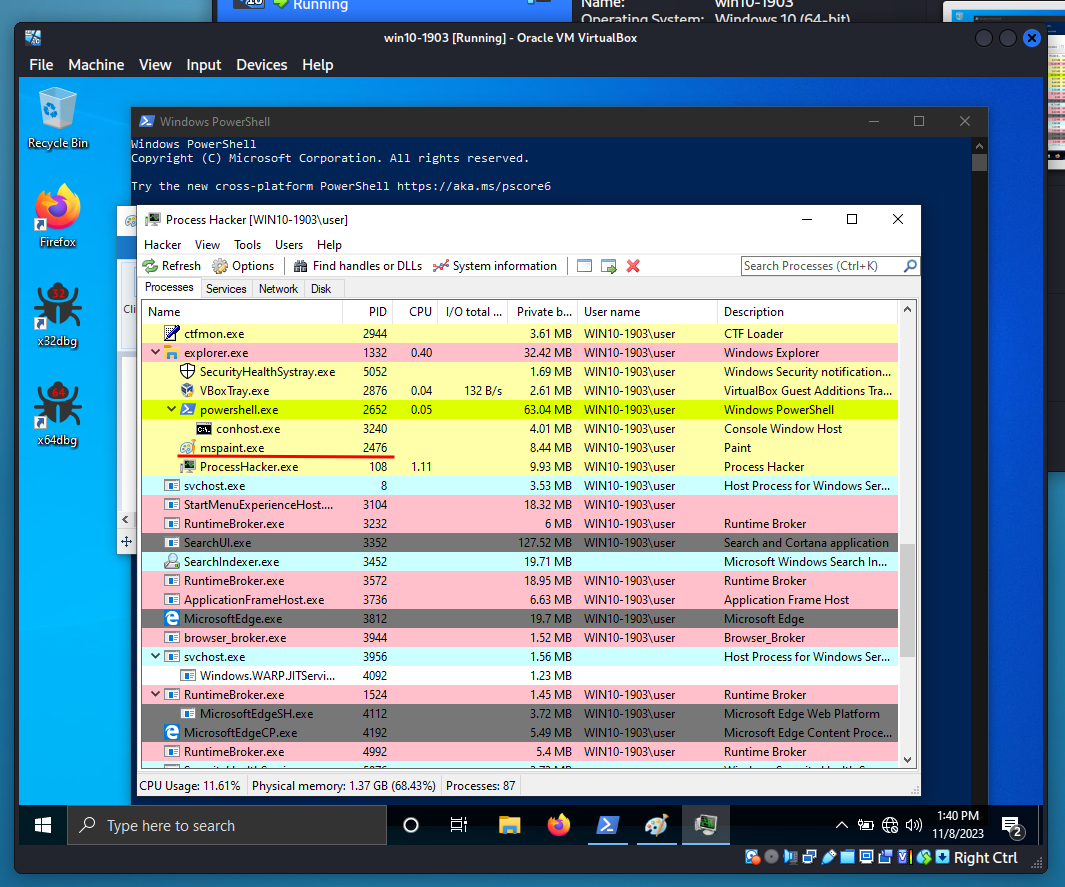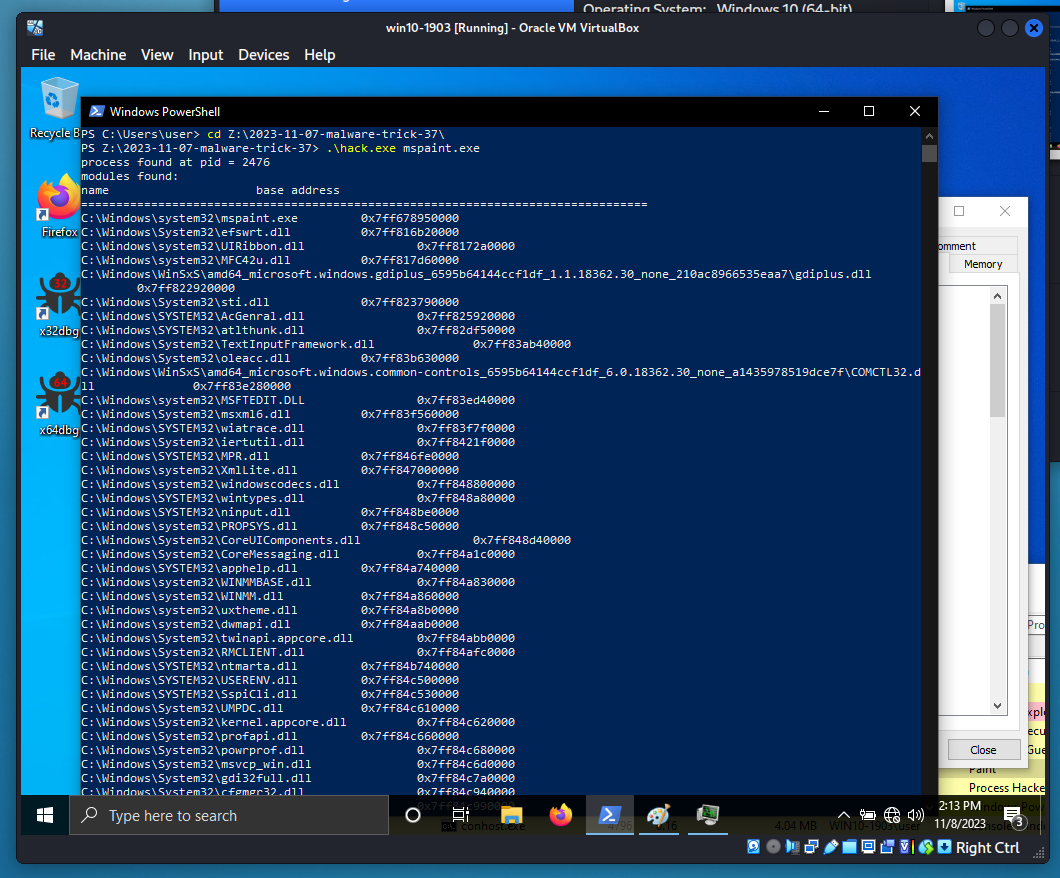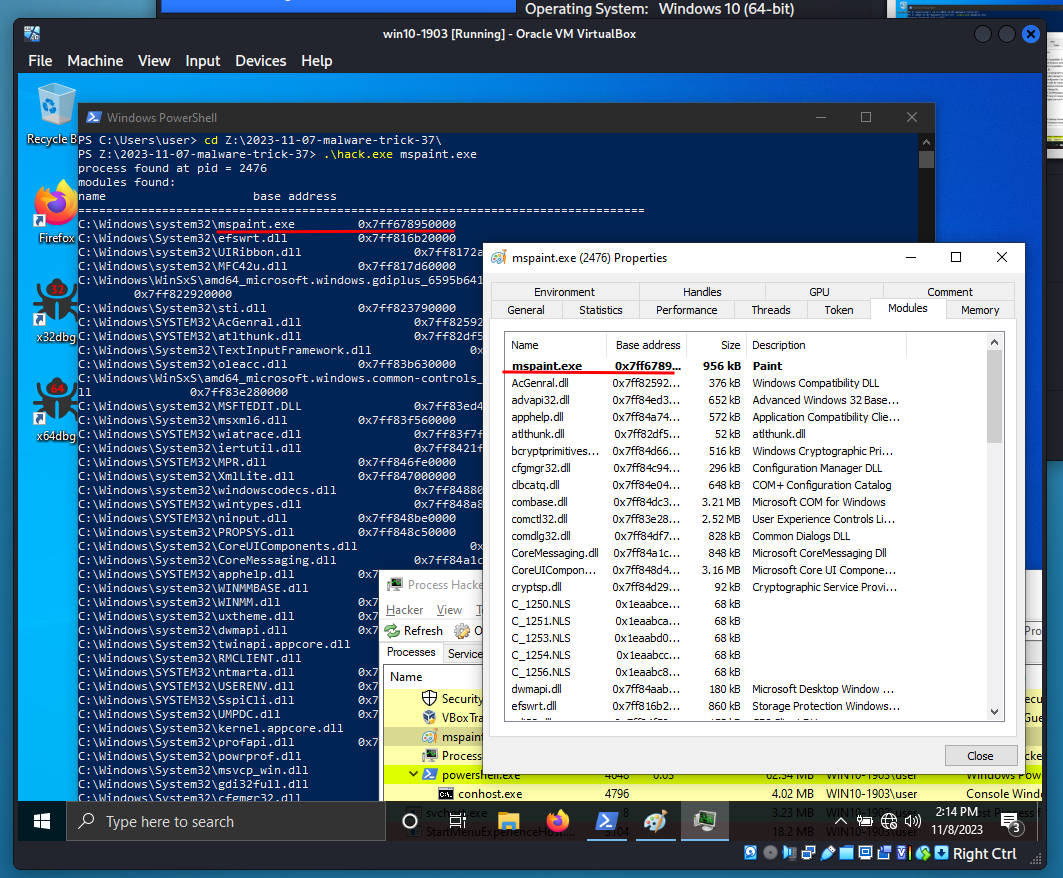﷽
Hello, cybersecurity enthusiasts and white hackers!

Today, this post is the result of my own research on another popular malware development trick: get list of modules of target process.
It’s similar to my previous post about enum list of modules, but in this case I used VirtualQueryEx
practical example
First of all, we just use one of the methods to find target process PID. For example I used this one:
typedef NTSTATUS (NTAPI * fNtGetNextProcess)( _In_ HANDLE ph, _In_ ACCESS_MASK DesiredAccess, _In_ ULONG HandleAttributes, _In_ ULONG Flags, _Out_ PHANDLE Newph );int findMyProc(const char * procname) {
int pid = 0;
HANDLE current = NULL;
char procName[MAX_PATH];// resolve function address
fNtGetNextProcess myNtGetNextProcess = (fNtGetNextProcess) GetProcAddress(GetModuleHandle(“ntdll.dll”), “NtGetNextProcess”);// loop through all processes
while (!myNtGetNextProcess(current, MAXIMUM_ALLOWED, 0, 0, ¤t)) {
GetProcessImageFileNameA(current, procName, MAX_PATH);
if (lstrcmpiA(procname, PathFindFileName((LPCSTR) procName)) == 0) {
pid = GetProcessId(current);
break;
}
}
return pid;
}
Then, create function which opens a specified process, iterates through its memory regions using VirtualQueryEx, and retrieves information about the loaded modules, including their names and base addresses:
// function to list modules loaded by a specified process int listModulesOfProcess(int pid) { HANDLE ph; MEMORY_BASIC_INFORMATION mbi; char * base = NULL;ph = OpenProcess(PROCESS_QUERY_INFORMATION | PROCESS_VM_READ, FALSE, pid);
if (ph == NULL)
return -1;printf(“modules found:\n”);
printf(“name\t\t\t base address\n”);
printf(“=================================================================================\n”);while (VirtualQueryEx(ph, base, &mbi, sizeof(mbi)) == sizeof(MEMORY_BASIC_INFORMATION)) {
char szModName[MAX_PATH];// only focus on the base address regions if ((mbi.AllocationBase == mbi.BaseAddress) && (mbi.AllocationBase != NULL)) { if (GetModuleFileNameEx(ph, (HMODULE) mbi.AllocationBase, (LPSTR) szModName, sizeof(szModName) / sizeof(TCHAR))) printf("%#25s\t\t%#10llx\n", szModName, (unsigned long long)mbi.AllocationBase); } // check the next region base += mbi.RegionSize; }
CloseHandle(ph);
return 0;
}
As you can see, the code enters a while loop that continues as long as the VirtualQueryEx function successfully retrieves memory information. This loop iterates through memory regions within the target process.
Then checks whether the AllocationBase of the current memory region matches the BaseAddress. This condition ensures that it only focuses on the base address regions. If the conditions are met, it proceeds to retrieve the module name.
if (GetModuleFileNameEx(ph, (HMODULE) mbi.AllocationBase, (LPSTR) szModName, sizeof(szModName) / sizeof(TCHAR))) - The GetModuleFileNameEx function is called to retrieve the module filename associated with the current memory region’s base address. If successful, it stores the filename in szModName.
If the module name retrieval was successful, the code prints the module name and base address in a formatted manner.
After processing the current region, the base pointer is incremented by the size of the region to check the next region in the subsequent iteration of the loop.
That’s all.
So, the full source code is looks like this (hack.c):
/* * hack.c - get the list of * modules of the process via VirtualQueryEx. C++ implementation * @cocomelonc * https://cocomelonc.github.io/malware/2023/11/07/malware-tricks-37.html */ #include <windows.h> #include <stdio.h> #include <winternl.h> #include <tlhelp32.h> #include <shlwapi.h> #include <psapi.h>#pragma comment(lib, “ntdll.lib”)
#pragma comment(lib, “shlwapi.lib”)typedef NTSTATUS (NTAPI * fNtGetNextProcess)(
In HANDLE ph,
In ACCESS_MASK DesiredAccess,
In ULONG HandleAttributes,
In ULONG Flags,
Out PHANDLE Newph
);int findMyProc(const char * procname) {
int pid = 0;
HANDLE current = NULL;
char procName[MAX_PATH];// resolve function address
fNtGetNextProcess myNtGetNextProcess = (fNtGetNextProcess) GetProcAddress(GetModuleHandle(“ntdll.dll”), “NtGetNextProcess”);// loop through all processes
while (!myNtGetNextProcess(current, MAXIMUM_ALLOWED, 0, 0, ¤t)) {
GetProcessImageFileNameA(current, procName, MAX_PATH);
if (lstrcmpiA(procname, PathFindFileName((LPCSTR) procName)) == 0) {
pid = GetProcessId(current);
break;
}
}return pid;
}// function to list modules loaded by a specified process
int listModulesOfProcess(int pid) {
HANDLE ph;
MEMORY_BASIC_INFORMATION mbi;
char * base = NULL;ph = OpenProcess(PROCESS_QUERY_INFORMATION | PROCESS_VM_READ, FALSE, pid);
if (ph == NULL)
return -1;printf(“modules found:\n”);
printf(“name\t\t\t base address\n”);
printf(“=================================================================================\n”);while (VirtualQueryEx(ph, base, &mbi, sizeof(mbi)) == sizeof(MEMORY_BASIC_INFORMATION)) {
char szModName[MAX_PATH];// only focus on the base address regions if ((mbi.AllocationBase == mbi.BaseAddress) && (mbi.AllocationBase != NULL)) { if (GetModuleFileNameEx(ph, (HMODULE) mbi.AllocationBase, (LPSTR) szModName, sizeof(szModName) / sizeof(TCHAR))) printf("%#25s\t\t%#10llx\n", szModName, (unsigned long long)mbi.AllocationBase); } // check the next region base += mbi.RegionSize; }CloseHandle(ph);
return 0;
}
int main(int argc, char* argv) {
int pid = 0; // process ID
pid = findMyProc(argv[1]);
printf(“%s%d\n”, pid > 0 ? "process found at pid = " : "process not found. pid = ", pid);
if (pid != 0)
listModulesOfProcess(pid);
return 0;
}
demo
Let’s go to see this logic in action.
Compile it:
x86_64-w64-mingw32-g++ -O2 hack.c -o hack.exe -I/usr/share/mingw-w64/include/ -s -ffunction-sections -fdata-sections -Wno-write-strings -fno-exceptions -fmerge-all-constants -static-libstdc++ -static-libgcc -fpermissive -lpsapi -lshlwapi

Then, open target process in the victim’s machine:

And just run our hack.exe:
.\hack.exe mspaint.exe


As you can see, everything is worked perfectly! =^..^=
Keep in mind that this code may have limitations and dependencies on specific Windows APIs. Additionally, it relies on the process name for identification, which may not be unique.
This code can also help you develop your own script to work with process memory, for example for forensics or other tasks on blue team practical cases.
I hope this post spreads awareness to the blue teamers of this interesting malware dev technique, and adds a weapon to the red teamers arsenal.
VirtualQueryEx
GetModuleFileNameEx
Find process ID by name and inject to it
Find PID via NtGetNextProcess
source code in github
This is a practical case for educational purposes only.
Thanks for your time happy hacking and good bye!
PS. All drawings and screenshots are mine
Article Link: Malware development trick - part 37: Enumerate process modules via VirtualQueryEx. Simple C++ example. - cocomelonc